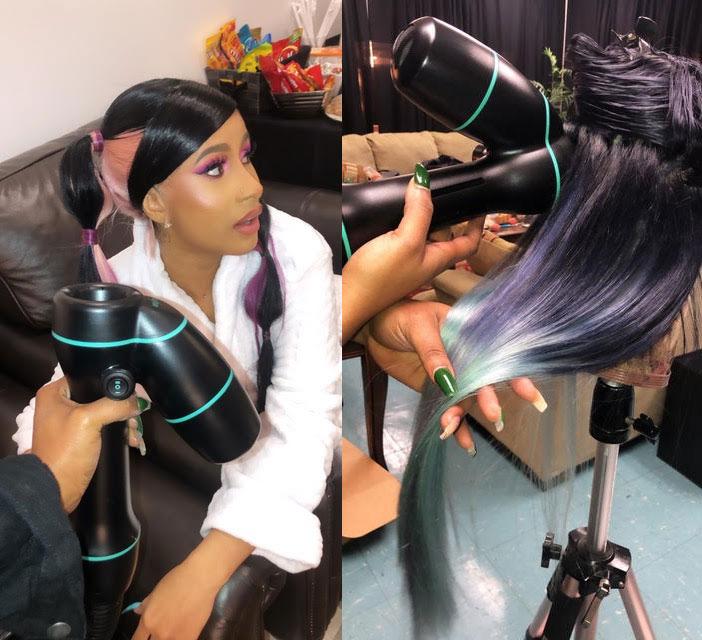
Understanding Synthetic vs. Human Hair Wigs
Thus far, we’ve given you all the tea on the best practices for healthy hair. What we haven’t done is given you insight on hair that doesn’t grow from your scalp. We briefly mentioned wigs in our protective styles blog post, but I’m sure there are many of you that have worn wigs or been interested to learn more about them.
This blog post will be a deep dive into the wig world. We’ll cover human hair wigs versus synthetic wigs, how to care for your wigs, how wigs are made and more.

This accessory’s use has evolved over the years, and so has the industry. Today, it largely caters to those who choose to use wigs as a cosmetic everyday accessory, whereas in the recent past, wigs have been known to be used mostly by people dealing with hair loss or hair thinning.
Wigs are a great way to get creative while doing minimal damage to your hair. Whether you want to change your look for a night out or add a wig to your daily beauty routine, wig options are virtually endless.
WHAT ARE WIGS MADE FROM?
Wigs can either be made from human hair or synthetic hair. If you don’t know, human hair wigs are very expensive. However, nowadays, the fiber that is used for synthetic wigs looks and feels just like human hair and is a fraction of the cost. One of the major downsides of synthetic wigs is that they cannot be dyed the same way human hair would be.
WHAT’S THE DIFFERENCE BETWEEN SYNTHETIC WIGS AND HUMAN HAIR WIGS?

Synthetic wigs are usually made of plastic or acrylic fibers that mimic hair. The fibers are heated to a certain temperature, then strung into strands that resemble human hair fibers. These hair strands are then woven into wefts, extensions and hair pieces.
The grade of these fibers may vary based on the manufacturer and will determine how realistic the wig looks on your head as well as the quality of the faux hair itself.
When choosing a synthetic wig that resembles natural hair, the best option is to inspect the hair against a human hair wig or your own natural hair. Looking at reviews from the manufacturer’s clients will also help you if you’re searching online. Some may include pictures to show how they look in various kinds of lighting or conditions.
Many synthetic textures that are curly can easily become tangled, matted and unwearable after just several weeks. When it comes to synthetic textures, it’s important to understand that the curlier the hair, the shorter the lifespan of the wig.
On the other hand, human hair wigs are made from, you guessed it, real human hair. In many cases, religious customs in the Brazilian and Indian communities require both men and women to shave their heads during spiritual rituals. These tresses can end up as natural wigs.
You may have also seen human hair wigs made from Peruvian or Malaysian hair. The hair then goes through a process of cleansing, sanitation and inspection before being designed into a beautiful natural hair wig.
Human hair wigs have a longer lifespan and can be cut to style, colored, bleached and heat styled as desired with the techniques you already know. That makes it simple to turn any blonde wigs into straight red human hair wigs, curled ombre looks, human hair bob wig styles and more. These natural fibers feature a more natural lay and flow than synthetic wigs. They can last for several months up to a year, provided you give them the proper care.
DIFFERENT TYPES OF WIGS
Wigs are a complex hairstyle because there are a few different types of wigs you can style and wear. There are three main types of wigs: lace frontal, 360 lace frontal and full lace wigs.
Lace Frontal Wigs

The popularity of “Lace Frontals” has grown significantly over the last few years. This is especially due to celebrities and social media influencers rocking them.
Lace frontal wigs give the appearance of a natural hairline. There are usually more options with the way you can part your hair as well.
In the world of wigs, “lace” refers to a fine, sheer mesh that hairs are individually tied to. A wig labeled “lace front” means that a piece of sheer lace mesh is located at the front of the wig cap.
Lace front wigs should be worn at or just in front of the natural hairline. To put on your wig, hold the wig by the ear tabs and flip the wig upside down with the interior of the cap facing up and the back of the wig farthest away from your body. Place the front of the wig cap on your forehead and slide the wig back over your head. Once you have your wig on, you can adjust the placement of your wig to give yourself the most flattering look.
There are different adhesive processes when applying a lace front wig. Hair glue is one of the most popular techniques used to secure wigs to the hairline.
360 Lace Frontal Wigs
A 360 lace frontal wig is very similar to a lace front in that they both have lace, however, a 360 lace frontal has lace all over the perimeter (360 degrees) and sometimes even the center. This creates a natural hairline look all around the perimeter of your head, allowing you to wear your hair in a ponytail while retaining that real-hair aesthetic.
Full Lace Wigs
A full lace wig has a base that is entirely made of lace. This means you are able to see the “scalp” when the hair is parted. A full lace wig will be more versatile for how you can style it, but it also means it will come at a higher price tag.
HOW DO I PREP FOR A WIG?
One of the most important steps in wearing a wig is how you prep your natural hair. It’s important to wash and condition your hair before wig installation. If your textured hair is long enough, you will want to cornrow your tresses to tuck them away. You should try to always wear a wig cap to protect your natural hair.
If you don't have hair because of hair loss due to a medical condition, bonded wigs are best for you. Double-sided tape, similar to garment tape that sticks to the skin, can also ensure the wig stays on your scalp.
Never wear a wig that you haven’t inspected and cleaned. You can shampoo and condition human hair wigs just as you would with your own natural hair. When learning how to care for wigs, real human hair makes it simpler because you already know the basics.
Some synthetic wigs can withstand shampoo, but it is best not to use it so you can avoid damaging the texture of the fibers. Dry shampoo or conditioner is best for synthetic wigs because it will refresh the wig and eliminate the abnormal shine. Be sure to choose a dry shampoo without benzene (which can cause cancer).
Because human hair wigs should be treated like your own hair, they must also be properly treated and maintained. Shampooing your wig twice a month, if worn daily, helps guarantee the healthy look of your human hair wig while maintaining its visual texture and feel.
Did you know you can dry wigs with the RevAir? Cardi B’s own hairstylist, Xia Charles, prepped her wig with it before a show.

The RevAir device works on human hair wigs just like it does on hair that’s on your head. It’s the perfect styling tool for getting your wig ready for installation because just like how traditional blow dryers can damage your hair, they can also damage your wig over time.
WIGS ARE A FORM OF EXPRESSION
Although many people wear wigs due to hair loss or hair thinning or as a protective style, the option to wear a wig gives everyone the ability to express their creativity. Synthetic wigs come in a variety of colors and styles, and human hair wigs give you the freedom to effortlessly dye your wig whatever color you desire.
There’s so much information on wigs that we don’t want to overwhelm you. Stay tuned for our wig blog post on how to properly install, care for and even make your own wigs.














